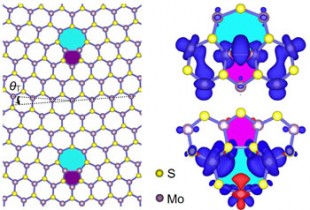Nov 15 2013
According to a new theory by Rice University scientists, imperfections in certain two-dimensional materials create the conditions by which nanoscale magnetic fields arise.
 Atomic dislocations can become magnetically charged when two-dimensional sheets of molybdenum disulfide and other dichalcogenides meet at an angle. The grain boundaries force atoms out of their hexagonal patterns (left) and keep electron spins from canceling each other out, creating nanoscale magnetic fields (right, in blue) in the process. Image by Zhuhua Zhang
Atomic dislocations can become magnetically charged when two-dimensional sheets of molybdenum disulfide and other dichalcogenides meet at an angle. The grain boundaries force atoms out of their hexagonal patterns (left) and keep electron spins from canceling each other out, creating nanoscale magnetic fields (right, in blue) in the process. Image by Zhuhua Zhang
Calculations by the lab of Rice theoretical physicist Boris Yakobson show these imperfections, called grain boundaries, in two-dimensional semiconducting materials known as dichalcogenides can be magnetic. This may lead to new strategies for the growing field of spintronics, which takes advantage of the intrinsic spin of electrons and their associated magnetic fields for electronic and computing devices.
The discovery by Yakobson, lead author Zhuhua Zhang and their colleagues was reported online this week in the American Chemical Society journal ACS Nano.
Dichalcogenides are hybrids that combine transition metal and chalcogen atoms, which include sulfur, selenium and tellurium. The Yakobson group focused on semiconducting molybdenum disulfide (MDS) that, like atom-thick graphene, can be grown via chemical vapor deposition (CVD), among other methods. In a CVD furnace, atoms arrange themselves around a catalyst seed into familiar hexagonal patterns; however, in the case of MDS, sulfur atoms in the lattice alternately float above and below the layer of molybdenum.
When two growing blooms meet, they’re highly unlikely to line up, so the atoms find a way to connect along the border, or grain boundary. Instead of regular hexagons, the atoms are forced to find equilibrium by forming adjoining rings known as dislocations, with either five-plus-seven nodes or four-plus-eight nodes.
In graphene, which is generally considered the strongest material on Earth, these dislocations are weak points. But in MDS or other dichalcogenides, they have unique properties.
“It doesn’t matter how you grow them,” Yakobson said. “These misoriented areas eventually collide, and that’s where you find topological defects. It turns out that – and I like this mechanistic metaphor – they squeeze magnetism out of nonmagnetic material.”
In previous work, Yakobson found dislocations create atom-width conducting lines and dreidel-shaped polyhedra in MDS. This time, the team dug deeper to find that dislocation cores turn magnetic where they force spinning electrons to align in ways that don’t cancel each other out, as they do in a flawless lattice. The strength of the magnets depends on the angle of the boundary and rises with the number of dislocations necessary to keep the material energetically stable.
“Every electron has charge and spin, both of which can carry information,” Zhang said. “But in conventional transistors, we only exploit the charge, as in field-effect transistors. For newly emerged spintronic devices, we need to control both charge and spin for enhanced efficiency and enriched functions.”
“Our work suggests a new degree of freedom — a new controlling knob — for electronics that use MDS,” Yakobson said. “The ability to control the magnetic properties of this 2-D material makes it superior to graphene in certain respects.”
He said the dislocation rings of four and eight atoms are not energetically favored in graphene and unlikely to occur there. But in the materials that mix two elements, certain grain boundary configurations will very likely create conditions where similar elements, wishing to avoid contact with each other, will instead bond with their chemical opposites.
“The system avoids mono-elemental bonds,” Yakobson said. “The chemistry doesn’t like it, so four-eight offers a benefit.” Those defects are also the strongest sources of magnetism at certain grain boundary angles, he said; at some angles, the boundaries become ferromagnetic.
The team proved its theory through computer models designed to isolate and control the effects of the nanoribbons’ edges and grain boundary dipoles that could skew the results. They also determined that grain boundary angles between 13 and 32 degrees force a progressive overlap between the dislocations’ spins. With sufficient overlap, the spins become magnetically coupled and broaden into electronic bands that support spin-polarized charge transport along the boundary.
Now, Yakobson said, “The challenge is to find a way to experimentally detect these things. It’s quite difficult to resolve it at this spatial resolution, especially when some of the experimental methods, like electron beams, would destroy the material.”
Co-authors of the paper are Rice postdoctoral researcher Xiaolong Zou and Vincent Crespi, distinguished professor of physics, materials science and engineering, and chemistry at The Pennsylvania State University. Yakobson is Rice’s Karl F. Hasselmann Professor of Mechanical Engineering and Materials Science, a professor of chemistry and a member of the Richard E. Smalley Institute for Nanoscale Science and Technology.
A U.S. Army Research Office Multidiscipline University Research Initiative grant, the National Science Foundation and the Robert Welch Foundation supported the research. Computations were performed on the Data Analysis and Visualization Cyberinfrastructure supercomputer administered by Rice’s Ken Kennedy Institute for Information Technology.